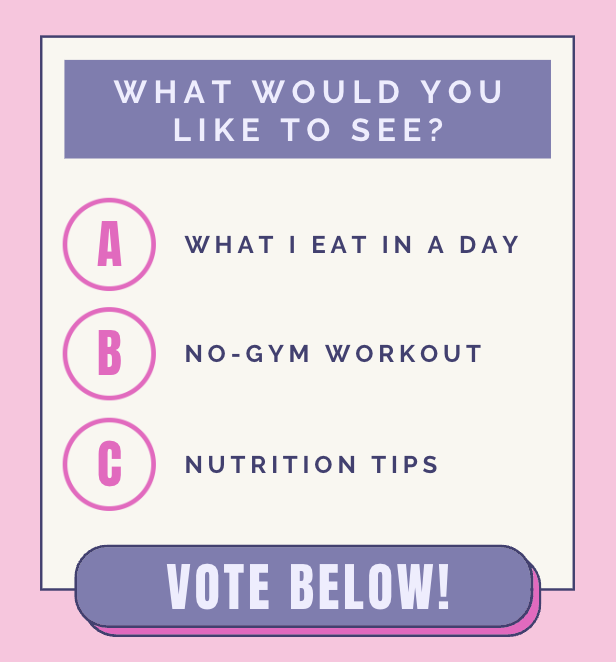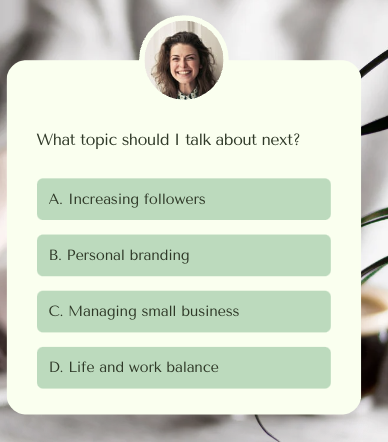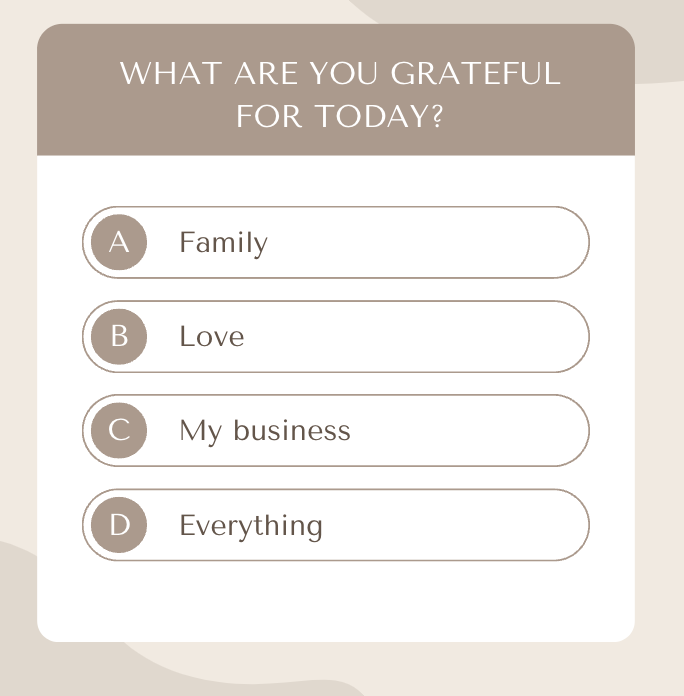“Engage, don’t just communicate. Ask, don’t just assume. The feedback you seek will define the growth you experience.”
Poll popups are interactive pop-up elements that appear on a website to gather feedback from visitors in the form of polls or surveys. They usually ask simple, targeted questions, encouraging users to share their opinions in real-time. Unlike traditional popups, which may aim to drive sales or collect email addresses, poll popups are designed to engage users, collect insights, and help businesses understand what their audience thinks or prefers. These popups allow for immediate interaction, often resulting in higher response rates and more meaningful user engagement.
To make sure you're not just communicating with your audience but engaging them, poll popups are an excellent tool. They ask the right questions and collect the right data without disrupting the user experience. By presenting the user with a single or multiple-choice question, they offer real-time feedback, making them a key asset for improving website performance, tailoring marketing efforts, and enhancing customer experience.
Understanding Poll Popups

How Poll Popups Work
Poll popups are simple but highly effective. At their core, they work by triggering a popup window that asks users one or more questions. These questions are usually presented in the form of multiple-choice, rating scales, or short text responses. Users can provide their input with just a few clicks, making it a frictionless experience. The simplicity of the process is what makes poll popups so powerful.
Poll popups typically operate using the following mechanisms:
Trigger-Based Appearance: Poll popups appear based on user behavior, such as scroll depth, time on page, or exit intent. This ensures that the popup reaches the user at a time when they are most likely to interact.
Automated Responses: Once a user completes the poll, they may receive a thank-you message or be redirected to another part of the website based on their response. This is useful for guiding users toward a product page or content tailored to their interests.
Data Collection and Storage: The responses from poll popups are typically stored in a back-end system or an integrated analytics tool, allowing website owners to review and act upon the data. This makes it easy to analyze user behavior and implement data-driven improvements.
Types of Poll Popups
Poll popups come in various formats, each designed to gather specific types of information. Understanding the right type of poll to use based on your goals is critical for maximizing the effectiveness of your poll popup strategy. Here are the main types:
Single-Choice Polls
In this format, users are asked a question and can only select one answer. Single-choice polls are ideal for gathering opinions on a specific topic, such as "Which feature do you find most useful?" This type is particularly effective for clear, straightforward questions that don't require complex responses.Multiple-Choice Polls
Multiple-choice polls allow users to select more than one answer, providing a broader understanding of their preferences. For instance, if you want feedback on product features, you might ask, "Which of these features do you use regularly?" and allow users to choose several options. This format is great for uncovering nuanced user preferences.Rating Scales
Rating scale polls ask users to rate a product, service, or experience on a scale (e.g., 1-5 stars). These are particularly useful for gauging user satisfaction and understanding the strength of user preferences.Open-Ended Polls
For more detailed feedback, you can use open-ended polls that allow users to type in their responses. These are best for qualitative insights, though they require more effort from the user. Open-ended polls are valuable when looking for specific suggestions or ideas, such as "How can we improve your experience?"
Where to Use Poll Popups on Your Website
Strategically placing your poll popups on different parts of your website is crucial to maximizing visibility and ensuring high participation rates. Here are some of the most effective places to use them:
Homepage:
Using a poll popup on your homepage can quickly engage users and provide insights into why they’ve visited your site. This is a great opportunity to ask questions like "What brought you here today?" or "What are you hoping to find?"Blog Posts or Articles:
Place poll popups within blog posts to ask readers for feedback on the content or to discover what topics they’d like to read more about. This type of engagement can significantly increase content relevance and user satisfaction.Product Pages:
On e-commerce sites, placing a poll on product pages allows you to ask users about their purchase intentions or feedback on specific features. This can help improve product offerings and tailor your marketing efforts.Checkout or Cart Pages:
Poll popups on these pages can gather feedback from users who abandon their carts or who may be hesitating at checkout. Asking "What’s stopping you from completing your purchase?" can provide valuable insights to optimize the checkout process and reduce cart abandonment rates.Exit-Intent Popups:
These appear when a user is about to leave the website. Exit-intent polls are a great way to catch users before they go, asking why they’re leaving or if there’s something that could be improved. This type of poll is highly effective for understanding potential issues with your site.
Benefits of Using Poll Popups
Boosting User Engagement
One of the most significant benefits of using poll popups is that they boost user engagement. In an online environment where users are often distracted or overwhelmed by content, getting them to interact with your website can be challenging. Poll popups, however, offer a solution by providing a direct, simple method of interaction.
Engagement is key to keeping visitors on your website longer. Poll popups achieve this by:
Encouraging Interaction: When users are asked for their opinion or feedback, they feel more invested in the experience. This makes them more likely to spend additional time on your site.
Breaking Content Monotony: If a user is scrolling through long-form content or browsing products, a poll popup offers a break from passive browsing, turning it into an active experience.
Offering Immediate Value: Users often appreciate when their opinions are asked for and valued. Polls that promise an immediate reward or acknowledgment, such as a "thank you" or even a discount code for completing the poll, provide additional motivation for participation.
According to research, interactive elements, like polls, can increase engagement rates by up to 300% compared to static content. This makes poll popups an invaluable tool for keeping users on your page and encouraging further exploration.
Collecting Actionable Feedback
Another crucial benefit of poll popups is their ability to gather actionable feedback from your website visitors. Instead of relying solely on traffic data or page metrics, you can directly ask users what they think or what they need. This type of qualitative data is incredibly valuable for making informed decisions about your content, design, or products.
Here’s how poll popups help collect actionable feedback:
Real-Time Insights: Unlike surveys that users may ignore in their inbox, poll popups allow you to get instant feedback while the user is actively engaged with your site.
Tailored Responses: With customizable poll options, you can focus on specific areas of improvement. For example, you can ask questions like "What do you think of our latest product update?" or "What could we do better?"
Prioritizing Features: For businesses developing products or services, poll popups can reveal which features are most important to your audience. By presenting options directly to users, you can gauge demand and prioritize development efforts.
Improving Content Strategy: Blogs and content websites can use poll popups to understand what topics their audience prefers. Polls asking "What type of content would you like to see next?" help guide your content creation efforts based on user demand.
Improving Conversion Rates
Poll popups can also be an effective tool for improving conversion rates. Whether you run an e-commerce store, a blog, or a service-oriented website, the insights you gain from poll popups can be used to refine your approach and increase the likelihood of conversions.
Here are some ways poll popups can drive conversions:
Identifying Pain Points: Polls can uncover reasons users aren’t converting. For example, an exit-intent poll asking "What prevented you from completing your purchase today?" can provide insights that help you optimize your checkout process or offer discounts at the right moment.
Personalizing Offers: Based on poll responses, you can create more personalized marketing campaigns or product recommendations. For instance, if a user indicates they’re interested in a particular feature, you can follow up with an email highlighting that aspect.
Improving Product Pages: Feedback collected from polls on product pages can reveal what’s missing or confusing about your product descriptions, photos, or prices. Implementing the suggestions made by users can lead to better-informed decisions and higher sales.
Increasing Lead Generation: Some polls can double as lead generation tools by asking users for their contact information in exchange for completing a survey. This helps grow your email list while gathering valuable insights.
Common Challenges with Poll Popups

While poll popups can be incredibly effective, they also come with their own set of challenges. Understanding these issues can help you implement strategies to overcome them, ensuring that your popups enhance rather than detract from the user experience.
Avoiding Survey Fatigue
Survey fatigue occurs when users become overwhelmed by too many requests for feedback. This can lead to disengagement, reduced participation rates, and even negative perceptions of your brand.
Tips to Avoid Fatigue:
Limit Frequency: Be mindful of how often you show poll popups to the same user. Consider implementing a time delay before displaying another poll.
Diversify Polls: Instead of asking for feedback on the same topics repeatedly, vary the subject matter to keep users engaged.
Monitor Participation Rates: Keep an eye on engagement metrics. If you notice a drop in participation, it may be time to reassess your approach.
Maintaining User Trust
Trust is crucial when asking users for feedback. Users are more likely to participate if they believe their data is secure and their opinions matter.
Strategies for Building Trust:
Be Transparent: Clearly communicate how you will use the poll data. Users appreciate knowing the purpose behind your questions.
Ensure Privacy: Use reputable tools that prioritize user data protection. Consider adding a privacy statement to your poll popups.
Showcase Impact: Share how previous feedback has influenced changes on your site or product. This demonstrates that you value user input.
Interpreting Poll Results Accurately
Gathering data is only the first step; interpreting it correctly is just as important. Bias in data interpretation can lead to misleading conclusions.
Best Practices for Accurate Interpretation:
Avoid Leading Questions: Ensure your poll questions are neutral and do not lead respondents toward a particular answer.
Analyze Context: Look at the broader context of the responses. Understand that one poll may not represent the entire user base.
Utilize Analytics Tools: Leverage tools that offer insights into the data collected, helping you identify trends and patterns accurately.
Measuring Success: Poll Popup KPIs

To determine the effectiveness of your poll popups, it's crucial to track and analyze specific key performance indicators (KPIs). These metrics will help you understand how well your polls are performing and where improvements can be made.
Participation Rate
The participation rate measures the percentage of website visitors who engage with your poll popups. This metric indicates how compelling your popups are and can help gauge user interest.
How to Measure:
Track the number of users who view the poll compared to those who participate.
Aim for a higher participation rate by optimizing the design and timing of your popups.
Completion Rate
The completion rate indicates how many users finish answering all the questions in your poll. A high completion rate suggests that your questions are engaging and easy to answer.
Improving Completion Rates:
Keep polls short and focused. Aim for 1-3 questions to encourage full participation.
Use progress indicators to show users how far along they are, motivating them to finish.
Impact on Conversion
Analyzing how poll responses correlate to website goals and conversions is essential. This KPI helps you understand if the feedback collected is leading to meaningful changes that drive results.
Steps to Analyze Impact:
Track conversion metrics before and after implementing changes based on poll feedback.
Look for trends that indicate whether specific responses correlate with increased conversions or user engagement.
Example of Tracking KPIs
| KPI | Definition | Target Metric |
|---|---|---|
| Participation Rate | Percentage of users who engage with the poll | > 15% |
| Completion Rate | Percentage of users who answer all questions | > 75% |
| Impact on Conversion | Increase in conversions linked to poll data | +10% over 3 months |
Creating Poll Popups Using Poper
Creating engaging poll px .,m opups with Poper is straightforward and user-friendly, designed to help you gather valuable insights while enhancing user interaction. Here’s a step-by-step guide on how to set up your poll popups effectively:
Step 1: Log In to Your Poper Dashboard
First, log in to your Poper account. If you don’t have one yet, signing up is quick and easy. Once logged in, navigate to your dashboard.
Step 2: Select "Create Popup"
In your dashboard, click on the “New Popup” button. This will take you to the popup creation interface where you can choose the type of popup you want to design.
Step 3: Choose the Poll Popup Template
Poper offers a variety of pre-designed templates. Select the poll popup template that suits your website’s aesthetic. You can customize the colors, fonts, and layout to align with your brand.
Step 4: Customize Your Poll Questions
In the template editor, you can easily modify the poll questions. Keep your questions concise and relevant to ensure users can quickly respond. Poper allows you to choose from different formats:
Single-Choice Questions: Users select one option.
Multiple-Choice Questions: Users can select multiple answers.
Rating Scales: Users rate their experience or preference on a scale.
Step 5: Add Response Options
For each question, add the relevant response options. Ensure they are clear and varied enough to gather meaningful data. You can use Poper’s smart suggestion tool to help generate engaging options.
Step 6: Set Display Triggers
Determine when and how often your poll popup will appear. Poper allows you to set triggers based on:
Time on Page: Show the popup after users have spent a specific amount of time on the page.
Scroll Depth: Trigger the popup when users scroll to a certain point.
Exit Intent: Display the poll when a user is about to leave the site, capturing their feedback before they go.
Step 7: Publish Your Poll Popup
Once you’re satisfied with the design and functionality, click on the “Publish” button. Your poll popup is now live and ready to collect valuable insights from your visitors.
Step 8: Preview and Test
Before going live, use Poper’s preview feature to see how your poll popup will look to users. Test the functionality to ensure everything works smoothly. Make any necessary adjustments based on your review.
Step 9: Analyze the Results
After your poll has been active for a while, head to the analytics section in your Poper dashboard. Here, you can track participation rates, completion rates, and gather insights from the responses collected. Use this data to inform decisions and improve user experience on your site.
Advanced Poll Popup Strategies

To truly maximize the potential of poll popups, implementing advanced strategies can elevate user engagement and drive insightful feedback. Here, we explore several innovative approaches that can enhance your polling efforts.
Gamifying Poll Popups
Gamification is a powerful tool that can make participating in polls more enjoyable and engaging. By adding game-like elements, you can motivate users to take part and even reward them for their participation.
How to Gamify:
Incentives: Offer discounts, points, or other rewards for completing polls.
Visual Elements: Use fun animations or graphics to create a more interactive experience.
Leaderboards: Introduce a competitive aspect by showing top responders or sharing results.
Poll Popups for Real-Time User Feedback
Real-time feedback is invaluable, especially during product launches or website updates. Poll popups can capture immediate reactions from users, providing insights that are timely and relevant.
Implementation Tips:
Triggering Events: Set popups to appear during specific events (e.g., after a new feature is introduced).
Immediate Follow-Up: Use follow-up polls shortly after events to gauge user sentiment.
Integration with Analytics: Connect real-time feedback with analytics tools to track changes in user behavior.
Using AI to Improve Poll Popup Questions
Leveraging artificial intelligence can help generate more effective and engaging poll questions. AI can analyze user behavior and preferences to create tailored questions that resonate with your audience.
Benefits of AI-Driven Polls:
Personalization: Customize questions based on user demographics or previous interactions.
Dynamic Adjustments: AI can adapt polls in real-time based on responses, making the experience more relevant.
Data Insights: Use AI analytics to identify patterns and trends in responses, guiding future polls.
FAQs
What’s the Best Number of Questions for a Poll Popup?
Keep it concise! Aim for 1 to 3 questions to maintain user interest and encourage completion.
How Often Should I Use Poll Popups on My Website?
Frequency matters. Use polls strategically; avoid overwhelming users by limiting them to once per session or during specific campaigns.
Can Poll Popups Be Used for Lead Generation?
Absolutely! Polls can be combined with opt-in offers, turning engaged users into potential leads by providing value in exchange for their feedback.
How Can I Ensure Poll Popups Don’t Hurt UX?
Balance is key. Design your polls to be unobtrusive, use clear language, and ensure they don’t interfere with the overall user experience.
Conclusion
As we navigate the digital landscape, poll popups emerge as a powerful tool for engaging users and gathering valuable insights. Their interactive nature not only enhances user experience but also provides businesses with actionable data to improve performance and conversions.




